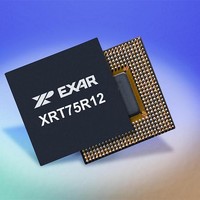XRT75R12DIB-F Exar Corporation, XRT75R12DIB-F Datasheet - Page 103

XRT75R12DIB-F
Manufacturer Part Number
XRT75R12DIB-F
Description
Peripheral Drivers & Components (PCIs) 12 Channel 3.3V-5V temp -45 to 85C
Manufacturer
Exar Corporation
Datasheet
1.XRT75R12DIB-F.pdf
(133 pages)
Specifications of XRT75R12DIB-F
Maximum Operating Temperature
+ 85 C
Minimum Operating Temperature
- 40 C
Mounting Style
SMD/SMT
Operating Supply Voltage
3.3 V to 5 V
Package / Case
TBGA-420
Lead Free Status / RoHS Status
Lead free / RoHS Compliant
- Current page: 103 of 133
- Download datasheet (851Kb)
REV. 1.0.3
What does this mean at the "Destination" PTE?
In this case, this DS3 signal (which has now been mapped into an STS-1 data-stream) will be transported
across the SONET network. As this STS-1 signal arrives at the "Destination" PTE, this PTE will extract (or de-
map) this DS3 data from each incoming STS-1 SPE. Now, in this case most (e.g., 177/178.8) of the incoming
STS-1 SPEs will contain 5592 DS3 data-bits. Therefore, the nominal data rate of the DS3 signal being de-
mapped from SONET will be 44.736Mbps. However, in approximately 1 out of every 178 incoming STS-1
SPEs, the SPE will carry 5593 DS3 data-bits. This means that (during these times) the data rate of the de-
mapped DS3 signal will have an instantaneous frequency that is greater than 44.736Mbps. These "excursion"
of the de-mapped DS3 data-rate, from the nominal DS3 frequency can be viewed as occurrences of "mapping/
de-mapping" jitter. Since each of these "bit-stuffing" events involve the insertion of one DS3 data bit, we can
say that the amplitude of this "mapping/de-mapping" jitter is approximately 1UI-pp. From this point on, we will
be referring to this type of jitter (e.g., that which is induced by the mapping and de-mapping process) as "de-
mapping" jitter.
Since this occurrence of "de-mapping" jitter is periodic and occurs once every 22.35ms, we can state that this
jitter has a frequency of 44.7Hz.
In this case, let us assume that a DS3 signal, with a bit-rate of 44.736Mbps - 1ppm is being mapped into an
STS-1 signal with a bit-rate of 51.84Mbps + 0ppm. In this case, the following this will occur.
What does this mean at the "Source" PTE?
All of this means that as the "Source" PTE maps this DS3 signal, with a data rate of 44.736Mbps - 1ppm into an
STS-1 signal, most of the resulting "outbound" STS-1 SPEs will transport 5592 DS3 data bits (e.g., 3 Stuff
Opportunity bits will be carrying DS3 data bits, the remaining 6 Stuff Opportunity bits are "stuff" bits). However,
in approximately one out of 178.8 "outbound" STS-1 SPEs, there will be a need for a "positive-stuffing" event.
F
WHEN MAPPING IN A
8.2.2.3
IGURE
In general, most of the STS-1 SPEs will each transport 5592 DS3 data bits.
However, within a "one-second" period a DS3 signal that has a bit-rate of 44.736Mbps - 1ppm will deliver
approximately 45 too few bits below that of a DS3 signal with a bit-rate of 44.736Mbps + 0ppm. This means
that this particular signal will need to "positive-stuff" or exclude a DS3 data bit from mapping every (1/44.736)
= 22.35ms.
(22.35ms*8000) = 178.8 STS-1 SPEs.
46. A
TWELVE CHANNEL E3/DS3/STS-1 LINE INTERFACE UNIT WITH SONET DESYNCHRONIZER
N
The 44.736Mbps - 1ppm Case
44.736Mbps + 1ppm
I
LLUSTRATION OF THE
In other words, we will need to avoid mapping this DS3 data-bit about one in every
DS3
SIGNAL THAT HAS A BIT RATE OF
Source
Source
PTE
PTE
STS-1 SPE
DS3 Data
SPE # N
DS3 Data
5592
Bits
5592
Bits
SPE # N+1
DS3 Data
DS3 Data
TRAFFIC THAT WILL BE GENERATED BY THE
5592
Bits
5592
Bits
STS-1 SPE Data Stream
99
44.736M
SPE # N+177
DS3 Data
DS3 Data
BPS
5592
Bits
5592
Bits
+ 1
Extra DS3 Data
Bit Stuffed Here
PPM
SPE # N+178
DS3 Data
DS3 Data
5593
Bits
,
5593
Bits
INTO AN
SPE # N+179
DS3 Data
DS3 Data
STS-1
5592
Bits
5592
Bits
"S
XRT75R12D
SIGNAL
OURCE
" PTE,
Related parts for XRT75R12DIB-F
Image
Part Number
Description
Manufacturer
Datasheet
Request
R

Part Number:
Description:
Twelve Channel E3/ds3/sts-1 Line Interface Unit With Jitter
Manufacturer:
Exar Corporation
Datasheet:

Part Number:
Description:
BiCMOS Fixed, Quad, Voltage Output, Single or Dual Supply 8-Bit Digital-to-Analog Converter
Manufacturer:
Exar Corporation
Datasheet:

Part Number:
Description:
Manufacturer:
Exar Corporation
Datasheet:

Part Number:
Description:
Voltage-Controlled Oscillator
Manufacturer:
Exar Corporation
Datasheet:

Part Number:
Description:
INTEGRATED LINE TRANSMITTER
Manufacturer:
Exar Corporation
Datasheet:

Part Number:
Description:
Monolithic Function Generator
Manufacturer:
Exar Corporation
Datasheet:

Part Number:
Description:
CMOS Microprocessor Compatible Double-Buffered 12-Bit Digital-to-Analog Converter
Manufacturer:
Exar Corporation
Datasheet:

Part Number:
Description:
CMOS 6 BIT HIGH SPEED ANALOG TO DIGITAL CONVERTER
Manufacturer:
Exar Corporation
Datasheet:

Part Number:
Description:
Manufacturer:
Exar Corporation
Datasheet:

Part Number:
Description:
Manufacturer:
Exar Corporation
Datasheet:

Part Number:
Description:
8-Channel, Voltage Output 10 MHz Input Bandwidth 8-Bit Multiplying DACs with Serial Digital Data Por
Manufacturer:
Exar Corporation
Datasheet:

Part Number:
Description:
15 V CMOS Multiplying10-Bit Digital-to-Analog Converter
Manufacturer:
Exar Corporation
Datasheet:

Part Number:
Description:
Monolithic Function Generator
Manufacturer:
Exar Corporation
Datasheet:










